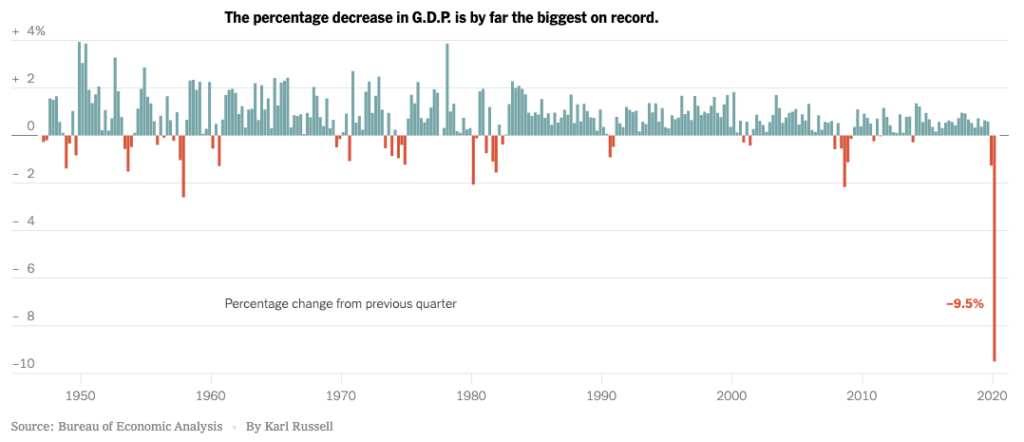Did the US economy just shrink 32.9%? No. Annualized rates are making a disaster seem even worse.

According to the headline in The Guardian, the U.S. economy just shrank 32.9%. USA Today agreed, saying “the second quarter Gross Domestic Product just plunged a record 32.9% from the previous quarter.”
Both of these statements are wrong.
As correctly reported in the New York Times, the economy — or more accurately, the GDP estimate — shrank by a record 9.5% in Q2, on top of a 1.2% drop in Q1. But how we got from there to 32.9% is an interesting story.
Annualizing rates of growth
Let’s start with a more normal quarter: Q4 of 2019. You know, back when things were going fine, before the virus hit.
According to news releases, in Q4 2019, the economy grew at an annualized rate of 2.1%. But of course, Q4 2019 is only one quarter of a year. So the economy didn’t actually grow 2.1% in Q4 — it grew at an annualized rate of 2.1%.
At first glance, you might assume this means that the economy grew in Q4 at one quarter of the growth rate of 2.1%, or 0.525%. Half a percent sounds like a pretty small number. That’s one reason that news reports always annualize the rate . . . to say that if the economy were to grow like this for a full year, it would grow at 2.1%. When, in happier times, President Trump stated that he thought the U.S. economy ought to grow at 4% per year, this is the rate he is referring to.
Except that what I just wrote about Q4 growth isn’t quite accurate. Growth compounds. So if the economy actually grew at 0.525% for four consecutive quarters, the growth rate would be:
(1.00525)×(1.00525)×(1.00525)×(1.00525) = 1.0211
That implies a growth rate of 2.11%
Wait a minute. Did a little error creep in there? Shouldn’t that be 2.1% exactly?
Not quite. Because, once again, we’ve been trapped by the battle of the shifting base. Four quarters of 0.525% growth compounds to 2.11%, slightly more than four times the 0.525% growth rate.
What about that huge decline in the GDP?
Why am I obsessing about the small extra amount? Because when the numbers are greater than a fraction of a percent, it matters. That’s why exponential growth (or decline) is so precipitous.
The actual decline in the GDP in Q2 2020 was 9.5%. What would happen if the economy declined 9.5% for four quarters in a row?
Easy answer: a decline of 9.5% times four, which is 38%. But that answer is wrong, because each successive decline would be on a smaller base.
After one quarter, the economy would be at 1 – 0.095 = .905, or 90.5% of its previous size.
After two such quarters, .905 × (1 – 0.095) = .819, or 81.9% of its previous size.
After three such quarters, .819 × (1 – 0.095) = .741, or 74.1% of its original size.
And after a full year of 9.5% shrinkage each quarter, .741 × (1 – 0.095) = .671, or 67.1% of its previous size.
(You can also compute this by taking 0.905 to the fourth power on your calculator or spreadsheet.)
That would be a 32.9% drop, which is the annualized rate that everyone is reporting.
How far will it fall?
The economy is unlikely to ever shrink this much again, short of a nuclear war. I feel confident predicting that the third quarter will not see a 9.5% drop (which would again be misreported as 32.9%).
How much will the economy shrink in 2020? More than 10%. Less than 25%. Your guess is as good as mine. At some point, people will continue to spend money — they have to eat, go to the doctor, and buy clothes for their kids. They may not be traveling or eating out like they used to, but some parts of the economy are doing just fine.
Forcing people back to work and school and watching them get sick in large numbers is not likely to help the economy.
Locking them their houses certainly won’t help either.
What we need is to pivot our economy to solutions to the virus problem, and other problems that are worth working on . . . and can be pursued in a transformed environment.
The news isn’t as bad as the 32.9% number makes it look. But it’s pretty damn bad. And we’d better understand what that means if we want to fix it.
You may be underestimating how dangerous this moment is. If the government continues to mismanage the pandemic and Congress falls sway to the concerns of those suddenly concerned about deficits, we could fall into a second Great Depression. GDP fell by about 23 percent in 1932, after two years of steep declines. We are smarter about monetary policy now and the Fed is still independent, so we probably won’t sink that much. But if the virus mutates to become more lethal because it is spreading so widely (possibly undermining the promising vaccines in the works) and the government response falters, all bets are off about how much economic carnage could occur.
PS, It generally makes sense to seasonally adjust quarterly or monthly data and present them at annual rates. It tells us how the current stats would translate into annual totals, assuming the trend continues.
Len, unlike you, I am not constrained by expertise.
I’m guessing we’ll see about a 25% contraction overall.
So yeah . . . great depression territory.